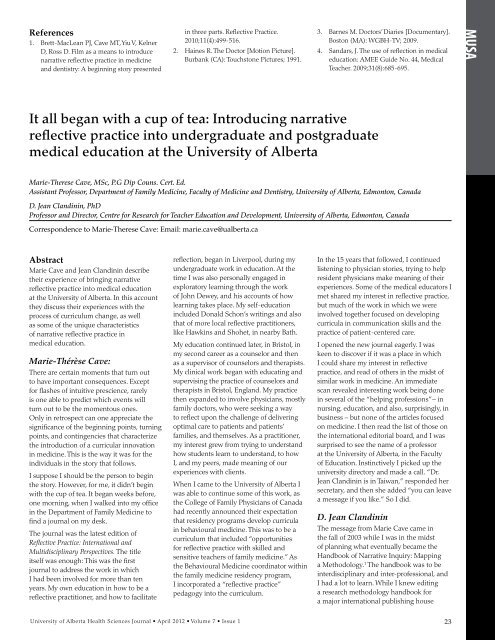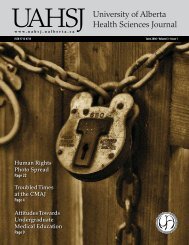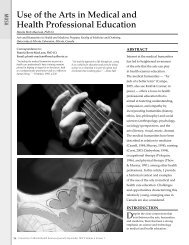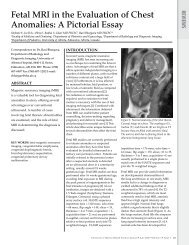MUSAAs <strong>of</strong>ten happens for busy clinician teachers,my schedule precluded my facilitating at thesame point in the course two years in a row,so the material discussed differed from oneyear to the next. Last year I had facilitateda small group after they watched the movieThe Doctor (1991) starring William Hurtas a callous surgeon who discovers he hascancer and must become a patient. 2 Theexperience changes the way he views hispatients, his family and his life. Although thefilm was fictional, it was based on a real-lifephysician’s memoir. This year I facilitated agroup discussion <strong>of</strong> The Doctors’ Diaries, acondensed version <strong>of</strong> the Nova documentaryseries which followed eight Harvard medicalstudents for fifteen years, from the first year<strong>of</strong> medical school, through residency, andinto practice. 3Facilitating the two groups was verydifferent. With last year’s group, thenarratives contained significant insightsabout the film The Doctor. Topics presentedin the students’ reflections included personalexperiences <strong>of</strong> illness, family support, worklifebalance, spirituality, and the concept<strong>of</strong> duty assumed upon entering a caringpr<strong>of</strong>ession. The students read descriptions<strong>of</strong> their own doctors, and also the kinds <strong>of</strong>doctors they wanted to be. Their writingstyles and abilities were varied, but theyhonoured each others’ stories, and thediscussion was very rich.Not so with this year’s group. At first, Ithought it was because <strong>of</strong> the materialused for this particular session—becauseit was a documentary, not a story, orperhaps because it was about a prestigiousivy-league school, and not “here”. Yetit was clear from the kinds <strong>of</strong> questionsand comments made during the paneldiscussion that the students had beenemotionally engaged with these real people,and threatened by the very real stresses theHarvard medical students experienced asdepicted in the film. There was somethingelse going on in my group’s session. Ishould have noted it then and put a stopto it because what was done was not whatwas intended, but I didn’t figure it out untilI myself reflected on the process for today’sworkshop.This is what happened. The first studenttook out what I thought was his writtennarrative, and instead <strong>of</strong> reading italoud, he presented his ideas in a casualconversational style as in any other groupdiscussion. When I glanced at his paper, Isaw it contained some thoughts scrawledacross the page in point format, likespeaker’s notes. Not a narrative. The nextstudent, who had written a full narrative,started to read but when she got to asentence that was similar in its theme tothe first student’s, she followed his lead andapologetically abandoned her text to wingit—“Oh, yeah, I sorta felt the same way,”and “I’ll skip that because it was the same ashe said,” and so on, essentially stripping herresponse <strong>of</strong> her individual writing style andall the personal narrative details—especiallythe careful selection <strong>of</strong> WHAT TO SAY.Those two students set the tone <strong>of</strong> thesession, and the other students followedsuit. No one read more than a fewsentences. Yes, there was a good discussionoverall, but the responses became muddledtogether, and at the end I could notidentify one distinctive story. Why had thishappened? The groups were the same sizeand equally varied in their backgroundsand experiences, we’d started with the sameintroductions process and the studentsseemed comfortable with each other.The session left me unsatisfied. I felt I hadsomehow not done my job as facilitatoralthough I wasn’t able to figure out what Ihad done wrong. I recalled the individualstudent voices from the year before intheir carefully chosen words and phrasingand compared that to the bland “Me,too”-ing <strong>of</strong> this year’s group. Even oneyoung woman who’d admitted duringthe introductions to having participatedin a poetry—yes, POETRY—group as anundergraduate, became self-conscious <strong>of</strong>her written attempts to create a voice andleft <strong>of</strong>f reading her text for the comfortable,conforming anonymity <strong>of</strong> chat.Perhaps you now can see why I havechosen to read this narrative script instead<strong>of</strong> casually discussing my experienceswith reflective writing. Writing and orallanguage are not the same. Oral language,by its speed and spontaneity, is inaccurate.We speak <strong>of</strong>f the cuff and in the moment,trying to communicate with someone whois physically present. This works becausewe have instantaneous feedback from ourcommunicative partners—in their bodylanguage, their attentiveness to the message,the quality <strong>of</strong> their response. If we’re notmaking sense, we know it—the listener asksquestions to clarify the message, and basedon these questions, we change what we aresaying—repeating, perhaps paraphrasing,altering word choice, even backtrackingor simplifying to arrive at understanding.Speech language pathologists with whomI work call this process “narrative repair.”People who are good communicators don’twait for the questions from the listenerto begin this process. They’re in there atthe first frown or lifted eyebrow, when theinternal “uh-oh” tells then they’d bettergo back and fix things, or they’ll lose theiraudience. They are already starting to pickup the pace before the increasing frequency<strong>of</strong> yawns tells them that they are beingboring. This does not happen with writtentext.In writing, the repair is in the edits andmust be done before the “speaker” ever“speaks” his piece, because any clarifyingfeedback will be removed in time and space.This forced clarification creates a powerfulcommunication tool. Spontaneous orallanguage is ephemeral, unless recorded orwritten down. We as listeners are left withan impression <strong>of</strong> someone else’s truth. Inwriting we aim to achieve our own truth.Writing should stand alone.In John Sandars’ 2009 article in MedicalTeacher he states that reflection is ametacognitive process. 4 I would add thatediting is also a metacognitive process—itrequires us to think about language, todeliberate and become deliberate in ourapproach to a communicative task. Theact <strong>of</strong> writing slows us down. We carefullyconsider the ways we use words to avoidthe possibilities for ambiguity that canambush the sought-after clarity and ultimatepresentation <strong>of</strong> our personal truth. Whenwe submit our final written draft, we are nolonger figuring out what we want to say. Weknow. We say, “THIS is what I think. THISis what I feel. THIS is what I believe.” NOT“I’ll say this about that”, but “THIS is what IWANT to say about THAT”.This is the lesson <strong>of</strong> narrative reflectivepractice, and should be our focus whenwe teach this to others: the deliberateconsideration <strong>of</strong> what we think and feel andbelieve, and the value <strong>of</strong> communicatingthese thoughts and feelings and beliefsthrough the deliberate consideration <strong>of</strong> thewritten word. The narrative reflectiveprocess was not as effective in my smallgroup this year, at least partially becauseI let the discussion stray from the writtenword. Despite the students’ emotionalengagement in The Doctor Diaries, thesuperficial conversations did not capturetheir individual reflections or link theexperience <strong>of</strong> viewing the film with theirown stories. The discussion never reacheddown to the very deep issues that had arisenfrom the film.Next year I know what to do. If any <strong>of</strong> thestudents wander away from their requestednarrative reflection, I am going to stopthem and say, “Please read what you wrote,because the words are important.”22<strong>University</strong> <strong>of</strong> <strong>Alberta</strong> <strong>Health</strong> <strong>Sciences</strong> <strong>Journal</strong> • April 2012 • Volume 7 • <strong>Issue</strong> 1
References1. Brett-MacLean PJ, Cave MT, Yiu V, KelnerD, Ross D. Film as a means to introducenarrative reflective practice in medicineand dentistry: A beginning story presentedin three parts. Reflective Practice.2010;11(4):499-516.2. Haines R. The Doctor [Motion Picture].Burbank (CA): Touchstone Pictures; 1991.3. Barnes M. Doctors’ Diaries [Documentary].Boston (MA): WGBH-TV; 2009.4. Sandars, J. The use <strong>of</strong> reflection in medicaleducation: AMEE Guide No. 44, MedicalTeacher. 2009;31(8):685-695.MUSAIt all began with a cup <strong>of</strong> tea: Introducing narrativereflective practice into undergraduate and postgraduatemedical education at the <strong>University</strong> <strong>of</strong> <strong>Alberta</strong>Marie-Therese Cave, MSc, P.G Dip Couns. Cert. Ed.Assistant Pr<strong>of</strong>essor, Department <strong>of</strong> Family Medicine, Faculty <strong>of</strong> Medicine and Dentistry, <strong>University</strong> <strong>of</strong> <strong>Alberta</strong>, Edmonton, CanadaD. Jean Clandinin, PhDPr<strong>of</strong>essor and Director, Centre for Research for Teacher Education and Development, <strong>University</strong> <strong>of</strong> <strong>Alberta</strong>, Edmonton, CanadaCorrespondence to Marie-Therese Cave: Email: marie.cave@ualberta.caAbstractMarie Cave and Jean Clandinin describetheir experience <strong>of</strong> bringing narrativereflective practice into medical educationat the <strong>University</strong> <strong>of</strong> <strong>Alberta</strong>. In this accountthey discuss their experiences with theprocess <strong>of</strong> curriculum change, as wellas some <strong>of</strong> the unique characteristics<strong>of</strong> narrative reflective practice inmedical education.Marie-Thérèse Cave:There are certain moments that turn outto have important consequences. Exceptfor flashes <strong>of</strong> intuitive prescience, rarelyis one able to predict which events willturn out to be the momentous ones.Only in retrospect can one appreciate thesignificance <strong>of</strong> the beginning points, turningpoints, and contingencies that characterizethe introduction <strong>of</strong> a curricular innovationin medicine. This is the way it was for theindividuals in the story that follows.I suppose I should be the person to beginthe story. However, for me, it didn’t beginwith the cup <strong>of</strong> tea. It began weeks before,one morning, when I walked into my <strong>of</strong>ficein the Department <strong>of</strong> Family Medicine t<strong>of</strong>ind a journal on my desk.The journal was the latest edition <strong>of</strong>Reflective Practice: International andMultidisciplinary Perspectives. The titleitself was enough: This was the firstjournal to address the work in whichI had been involved for more than tenyears. My own education in how to be areflective practitioner, and how to facilitatereflection, began in Liverpool, during myundergraduate work in education. At thetime I was also personally engaged inexploratory learning through the work<strong>of</strong> John Dewey, and his accounts <strong>of</strong> howlearning takes place. My self-educationincluded Donald Schon’s writings and alsothat <strong>of</strong> more local reflective practitioners,like Hawkins and Shohet, in nearby Bath.My education continued later, in Bristol, inmy second career as a counselor and thenas a supervisor <strong>of</strong> counselors and therapists.My clinical work began with educating andsupervising the practice <strong>of</strong> counselors andtherapists in Bristol, England. My practicethen expanded to involve physicians, mostlyfamily doctors, who were seeking a wayto reflect upon the challenge <strong>of</strong> deliveringoptimal care to patients and patients’families, and themselves. As a practitioner,my interest grew from trying to understandhow students learn to understand, to howI, and my peers, made meaning <strong>of</strong> ourexperiences with clients.When I came to the <strong>University</strong> <strong>of</strong> <strong>Alberta</strong> Iwas able to continue some <strong>of</strong> this work, asthe College <strong>of</strong> Family Physicians <strong>of</strong> Canadahad recently announced their expectationthat residency programs develop curriculain behavioural medicine. This was to be acurriculum that included “opportunitiesfor reflective practice with skilled andsensitive teachers <strong>of</strong> family medicine.” Asthe Behavioural Medicine coordinator withinthe family medicine residency program,I incorporated a “reflective practice”pedagogy into the curriculum.In the 15 years that followed, I continuedlistening to physician stories, trying to helpresident physicians make meaning <strong>of</strong> theirexperiences. Some <strong>of</strong> the medical educators Imet shared my interest in reflective practice,but much <strong>of</strong> the work in which we wereinvolved together focused on developingcurricula in communication skills and thepractice <strong>of</strong> patient-centered care.I opened the new journal eagerly. I waskeen to discover if it was a place in whichI could share my interest in reflectivepractice, and read <strong>of</strong> others in the midst <strong>of</strong>similar work in medicine. An immediatescan revealed interesting work being donein several <strong>of</strong> the “helping pr<strong>of</strong>essions” – innursing, education, and also, surprisingly, inbusiness – but none <strong>of</strong> the articles focusedon medicine. I then read the list <strong>of</strong> those onthe international editorial board, and I wassurprised to see the name <strong>of</strong> a pr<strong>of</strong>essorat the <strong>University</strong> <strong>of</strong> <strong>Alberta</strong>, in the Faculty<strong>of</strong> Education. Instinctively I picked up theuniversity directory and made a call. “Dr.Jean Clandinin is in Taiwan,” responded hersecretary, and then she added “you can leavea message if you like.” So I did.D. Jean ClandininThe message from Marie Cave came inthe fall <strong>of</strong> 2003 while I was in the midst<strong>of</strong> planning what eventually became theHandbook <strong>of</strong> Narrative Inquiry: Mappinga Methodology. 1 The handbook was to beinterdisciplinary and inter-pr<strong>of</strong>essional, andI had a lot to learn. While I knew editinga research methodology handbook fora major international publishing house<strong>University</strong> <strong>of</strong> <strong>Alberta</strong> <strong>Health</strong> <strong>Sciences</strong> <strong>Journal</strong> • April 2012 • Volume 7 • <strong>Issue</strong> 1 23






